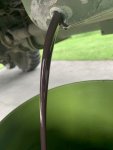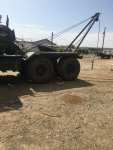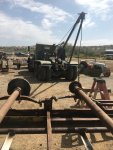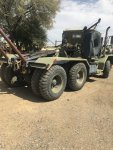Checked all my torque rod ends by flexing them, I do this around quarterly, they all pass, but are looking kind of crusty, I plated one last year that I think didnt flex back as it should. I drilled and tapped that one, I want to do the rest as a precaution, but it is a pain in the but, does anyone have any input on welding a bar across? Will it harm the bushing? I want to replace them eventually, but I want to make sure I don't have any problems with them popping off untill then. I use it as a fire truck on my property mostly.
View attachment 811688View attachment 811689View attachment 811688View attachment 811689
Opinions are like some parts that all of us have... Long ago in the dark ages, when we walked up hill in the snow to work (both ways - uphill to home and work!) I worked for a company that built powerlines in swamps and other "not nice" places. More than 95% of their equipment was World War II and Korean War MV's. We rebuilt those trucks from the frame up every seven years.
Brand new Torque Rods would show up on pallets in the rebuild shop. One of our welders would spend an entire day welding plates to the rods to keep them from popping off in a "rubber separation failure". The plate was a half inch thick with a 3/4" hole drilled in the center. Kinda like a "plug weld"... They would setup a quench bucket over a floor drain with continuous water going into the 5 gallon bucket. Weld one, quickly quench it, weld the next, drop it in and pull out the previous.
My opinion FWIW is that you have to remove the torque rods to get a good enough weld on them. Otherwise you burn up the rubber and get a separation you might never have had otherwise... I just don't think drilling and tapping would be as strong.
----
Story Time With Tim
There was a powerline down near Albemarle NC that company was contracted to build. I got the call to go "fix their five ton Texoma Digger". According to the foreman that I talked to, the "axles had come apart". Loaded two five ton rear axles, six torque rods, both rear driveshafts, brake lines and hoses and a bleeder and tools onto a trailer and headed down very early the next morning. Met somebody at the job site in a Deuce. Left all the parts where they were and drove to the sick truck. Not sure how that particular truck got to the field without the welded torque rods (guessing we bought it, it looked good, we painted it and put it to work). At least two rods had popped off. One axle walked forward, the other pushed off to the back and both were trying to rotate. Old age is setting in, but it seems that the only thing that kept those axles under the truck was that the driver stopped quickly and the driveshafts didn't break.
Ultimately we used a chain hoist (Coffing Hoist) that was a come-a-long on steroids and a 10 ton floor jack (thank goodness for boom trucks!) and hustled those axles back into place. Used chain to hold them in place and drove it in granny low very slowly to the top of the hill so we could work on flat ground. Looking back at it now, it was pretty STUPID of me to have driven that truck with no brakes at all. But it saved hours of trying to work on the side of a hill. We dropped in the torque rods and replaced both drive shafts (intermediate between the axles and transfer case to the front rear axle). Did some plumbing with steel brake line and replaced the two rubber hoses and bled the brakes. Got all that done in before the sun went down. Drove home in the dark - but it felt really good!
----
You have one heck of a fire truck there! She is an impressive looking machine. I hope you never have to use it for its intended purpose. On the other hand, if you can go save a neighbor - you can't beat having the RIGHT TOOLS for the job!



















